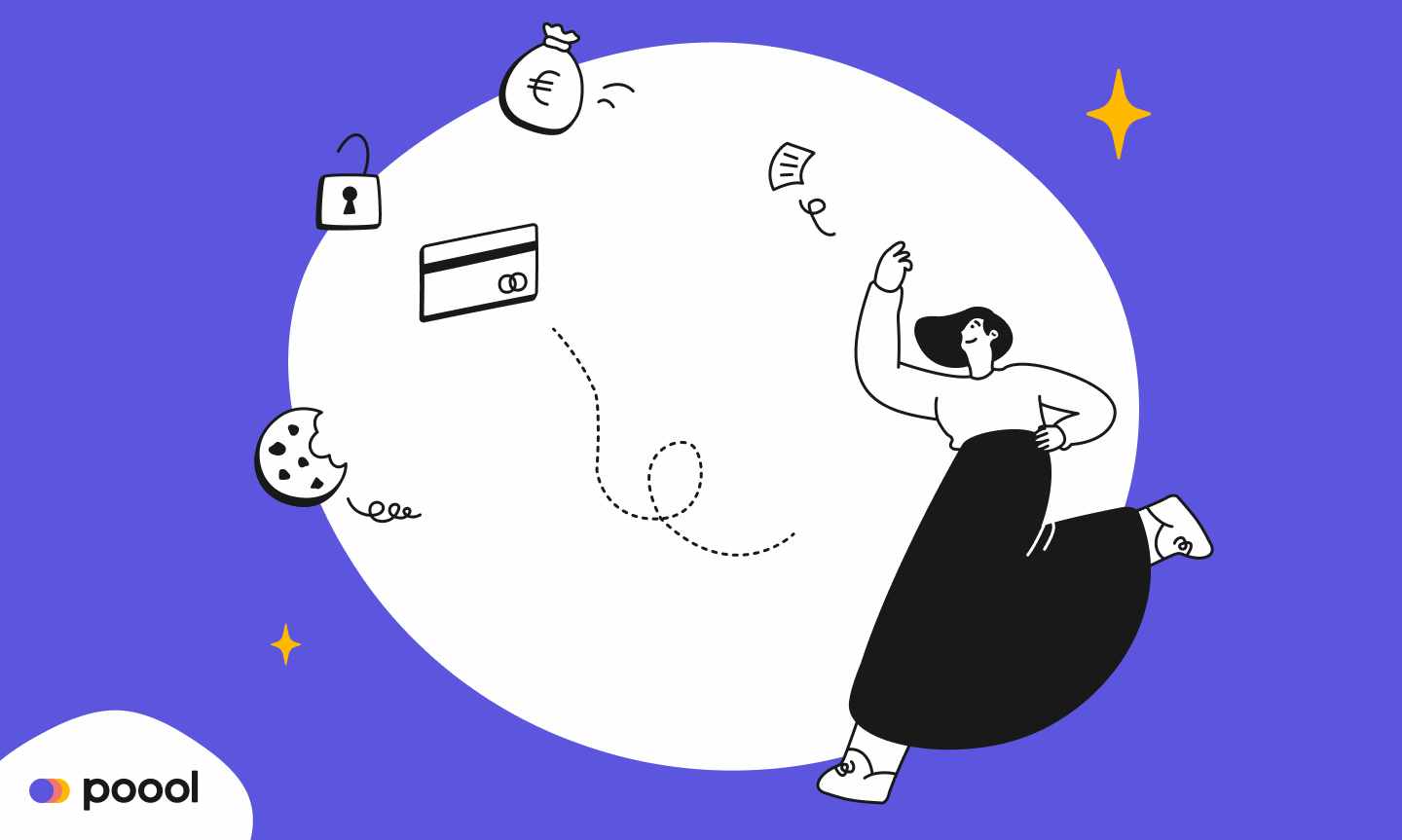Prefer to read in the language of Molière? 🇫🇷 C'est par ici !
Poool came together with Chartbeat to build on our white paper to provide engagement data and conversion strategies to sustainably increase reader revenue.
On the agenda:
- Quantifying the loyalty journey, including audience segmentation and content attribution models
- Monetizing conversion events, specifically how to gradually increase ARPU over time
- Adapting user experiences, such as on mobile vs desktop
- Key takeaways
1) Quantify the loyalty journey based on behavior and consumption
The different methodologies for measuring engagement can be based on either user behavior or consumption.
Behavior: engagement with your site
Poool recommends segmenting audiences based on a user's level of engagement, calculated through combining 3 key behavioral metrics -
- Recency: The number of days since a user last visited
- Frequency: The number of days a user has visited within a given time period
- Volume: The amount of content consumed/interactions (i.e. the quality of their visit)
This metric can be tracked globally and put into practice in defining user engagement segments. In the Poool Dashboard, this means 4 groups: Volatiles, Occasionals, regulars and Fans (although we can add on registered members).
Why is this methodology valuable?
Because audience conversion (and making your reading revenue strategy a success) comes down to balancing frustration and engagement.
Engagement is great, and you should always seek to increase engagement, but this isn't how you monetize your audience.
Whilst too much frustration (caused by blocking content) will make a user leave and find content elsewhere. However, it's this perfect amount of frustration that's needed to encourage a user to click through the wall and convert.
The data below gives a benchmark idea of our segmentation, taken from a study of 42 French publishers.
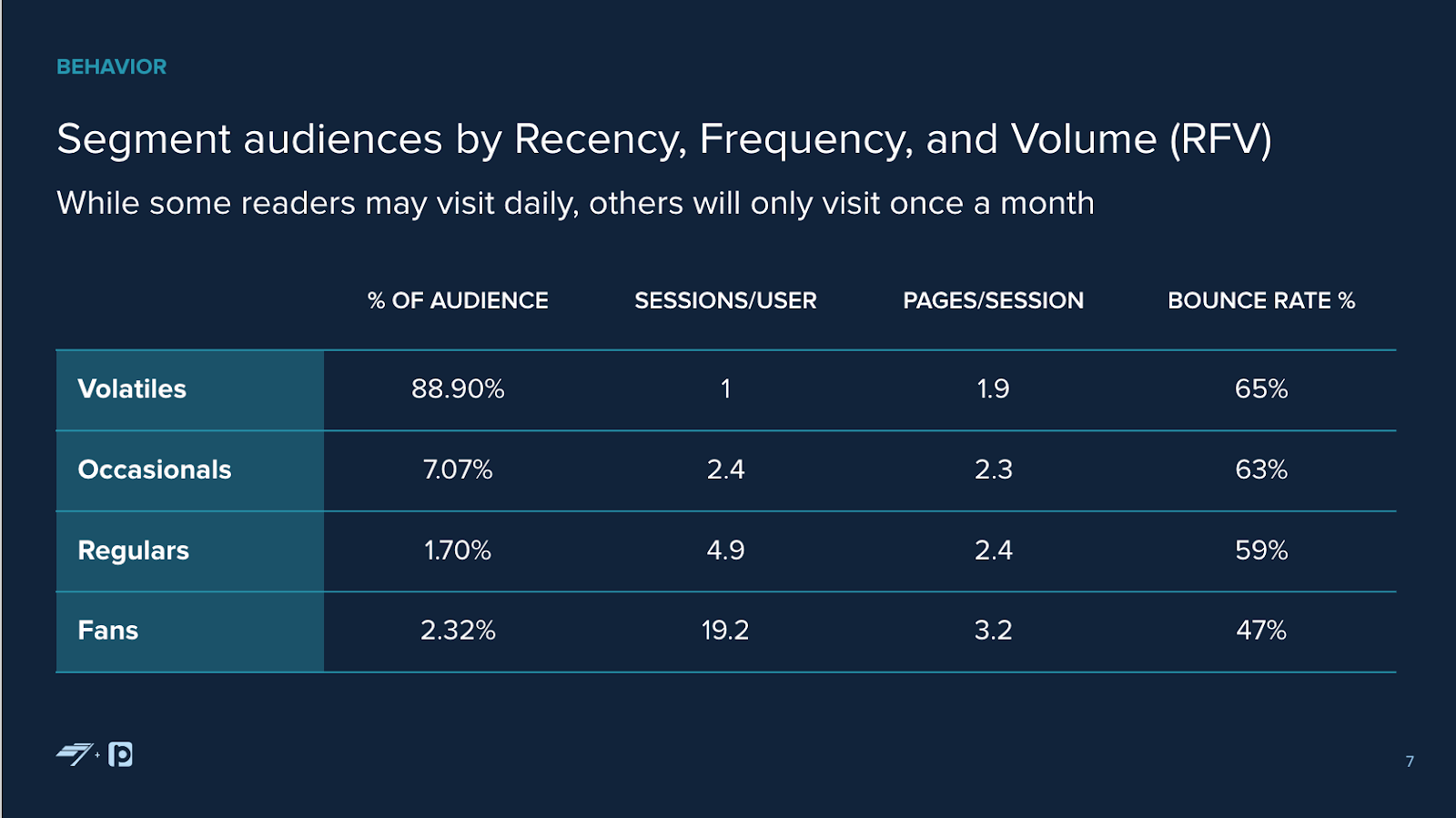
The main interesting point to note is the size of your least engaged audience group, who make up 88.9% of users in this data.
Given that conversion ultimately comes down to perfecting the balance of frustration and engagement, this means that the large majority of your audience are highly unlikely to subscribe if faced with a paywall...
Which is why, segmenting based on engagement is highly valuable for softly converting and monetizing even your most unengaged readers.
Consumption:
This is about understanding which areas of your content are actually driving users deeper down that funnel.
To help you get a clear picture of where to invest and prioritize, you can choose and track content attribution models that aligns with your strategy and goals. Discussing these models and really understanding what they are will play an important role in how you plan your content.
There are a variety of ways to attribute conversion events to particular pieces of content, some more simple than others.
- First touch: what was the first content that they consumed
- Last touch: what was the last thing they read that encouraged them to subscribe
- Linear touch: everything they touch over a period of time
- Most engaged touch: the content that the user engaged in the most
- Weighted linear: heavily weight towards recency - i.e. it'll still give credit to the earlier content consumptions but stronger credit to those that were reader closer to the conversion event
- Markov model: which pages, throughout your site, would have the biggest impact on conversion if that page was not present at all - i.e. if you removed X article, how much would conversions drop?
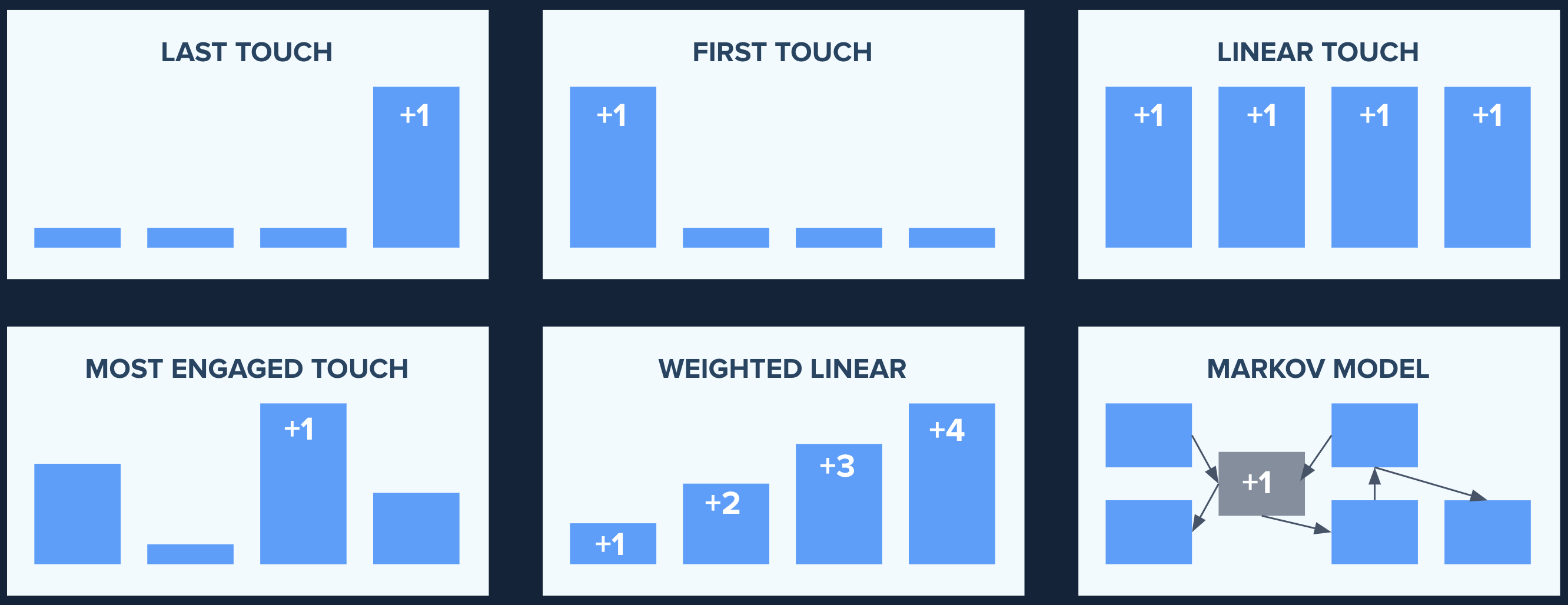
For each model you should consider:
- What is the methodology?
- What is the key question this model can help to answer?
- How does the model align to the conversion funnel? for instance how it helps move volatiles through towards higher engagement levels, or fans towards subscribing.
- How might you apply your findings?
Chartbeat's tip - go through the different models and align them with the conversion funnel to make sure that the attribution model that you choose fully supports your reader revenue strategy, because this will ultimately help you make better and smarter content decisions that will lead to more revenue.
Download the full webinar replay or slides here, as well as the original white paper that inspired this discussion.
We asked the audience which content attribution model they used:
Last click proved to be the most popular...
Which we pointed out isn't likely the most effective model for digital publishers in their reader revenue strategy, where engagement prior to the last click plays a considerable role in conversion rates. We go into more detail on this later.
2) Create seamless experiences that encourage conversion
How to you build better user experiences that are going to encourage conversions?
The assumption is that conversion only means subscription, but it actually refers to a variety of actions that users complete to move through the engagement funnel.
Of course though, these conversion events will have a different value for one publisher compared to another, so it's important to define which types of conversions are the most effective for increasing reader engagement on your site.
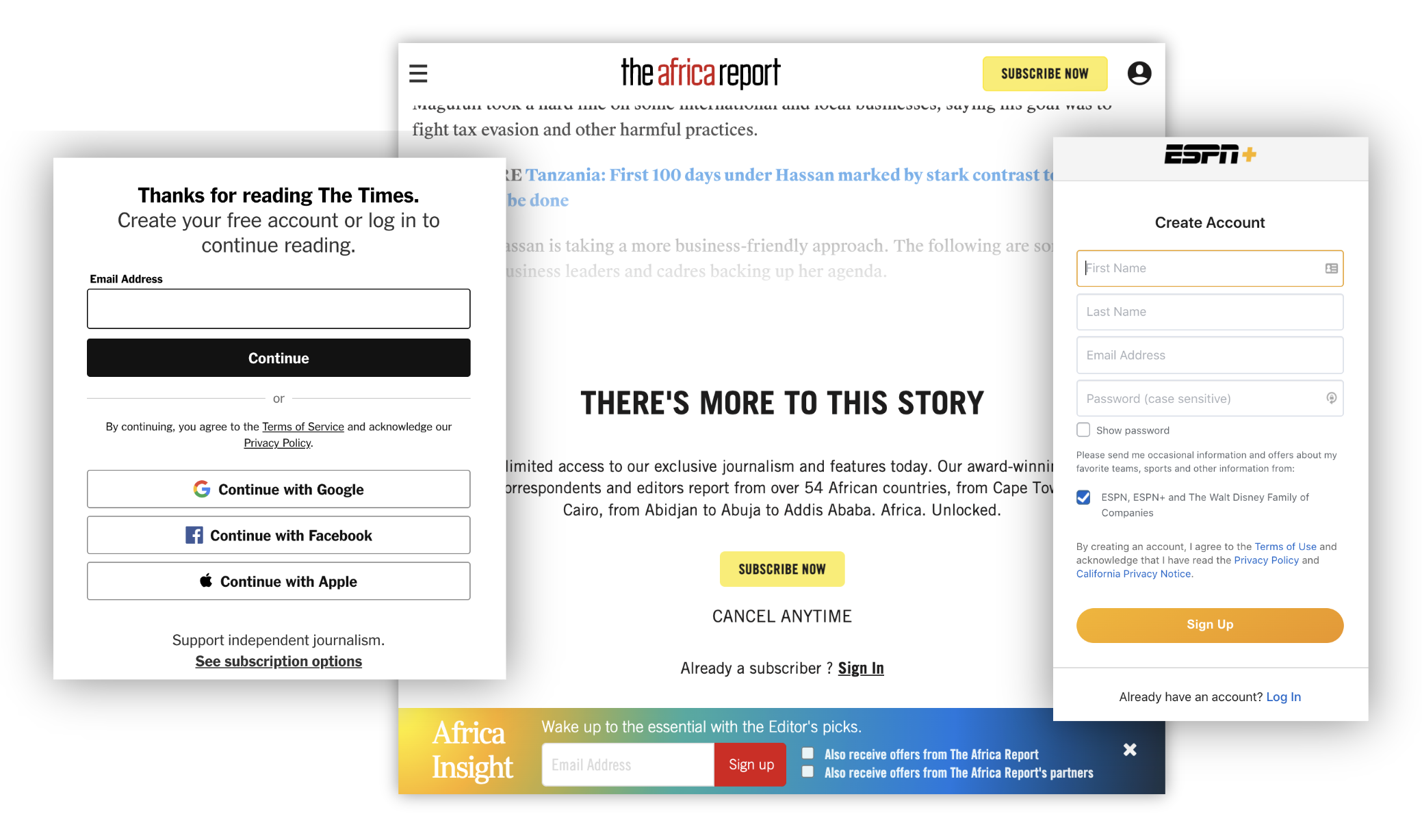
After segmenting visitors based on their level of engagement, evaluate the best soft conversion technique to encourage deeper and more frequent visits from each group, as well as bring you a higher ARPU.
To achieve this, it's important to move away from tracking conversion rate alone (the final touch)...
Why?
Because conversion rates were originally designed for the e-commerce industry where the buying process is a lot more about impulsive decision-making.
Instead, for content producers, the buying journey is all about gradually increasing engagement to bring you more revenue and hopefully lead to them subscribing in the future.
Which is why it's valuable to build smaller conversion steps in the user journey to continuously increase engagement, rather than simply presenting them with a paywall straight away, which we know isn't effective for monetizing the large majority of your audience.
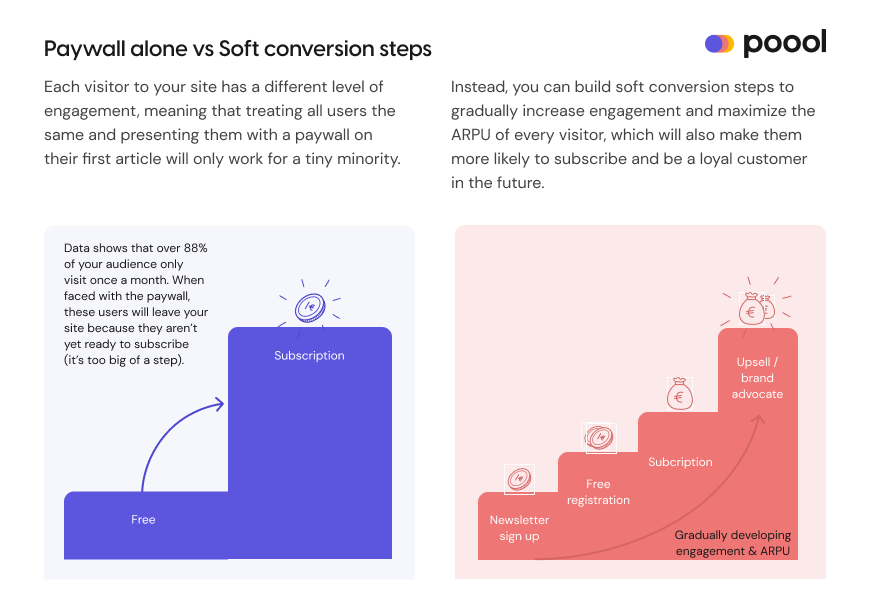
For instance, you could encourage a less engaged user to sign up to your newsletter through a newsletter wall, or create a free account via a registration wall. These will each increase engagement enough to make them more likely to subscribe when you do present the paywall.
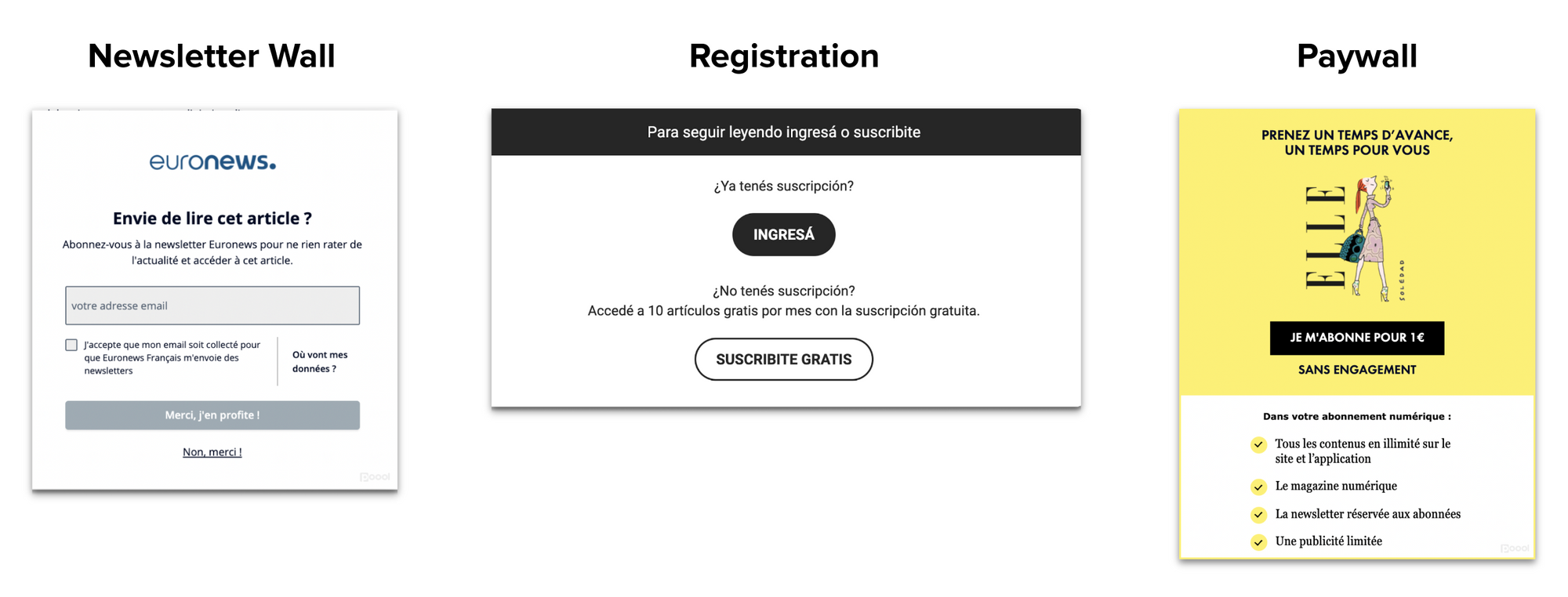
For instance, this data shows the value of turning an anonymous user into a registered member for your overall user-to-subscriber conversion rates.

Registration is also beneficial for:
- First-party data collection
- Better user experience
- Personalization (such as recommended content)
- Increase ad revenue through targeting
Serve content that aligns with reader preference at specific stages of their loyalty journey.
Although each publisher's audience will differ in how they engage with content, Chartbeat found some key commonalities between how content can be used to support your adapted loyalty journeys.
- Big, breaking news events are both traffic drivers as well as opportunities to build loyalty and drive conversion
- Games and puzzles play a considerable role in who will convert and who doesn't
- Politics and opinion covers also proved valuable, particularly opinions that tend to be unique to a given site. This type of content is great for increasing conversion rates as the user can't simply turn away from the paywall and consume content elsewhere, it's content that they can only access on your website - an essential part of the value exchange needed for conversions
- You could also block content with a survey wall, an engagement format and conversion step simultaneously
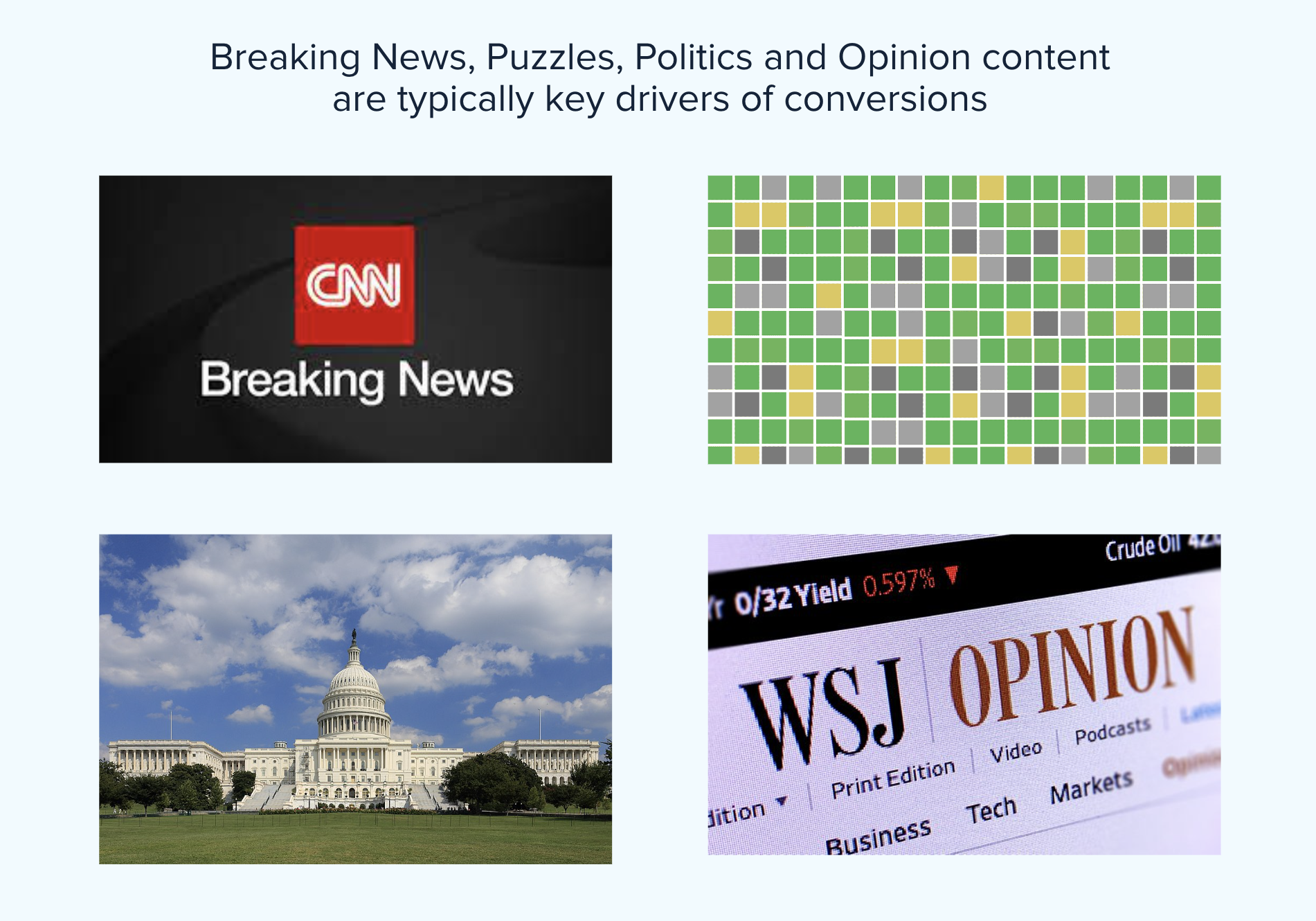
Another interesting finding from the study was that readers engaged much more deeply with the page after the conversion step than before.
And this makes sense - the user is giving something up in return for access to content, it's a commitment, so they want to dive in and spend more time with that page after conversion.
To make the most of this post-conversion moment, thank your user, make them feel valued and consider leading them through a short onboarding journey to encourage further engagement (e.g. newsletter sign-up, app download, etc).
This also links back to life-time value (LTV) of a user - it's not simply enough to convert and leave them. You have to continue to show value, understand how your users best engage with content and work hard on retention (that's highly more valuable and less costly to you than acquiring new subscribers).
Putting ARPU first
Given that readers are now at the heart of your reader revenue strategy, you should move from tracking overall user-to-subscriber conversion rates to instead measure ARPU (average revenue per user).
ARPU can be calculated for each audience segment based on the value of the actions and soft conversion steps completed by your users.
Firstly, give a monetary value to each engagement or soft conversion step.
This value may well be fake (like our table below) and not based on real revenue, but the important thing is that you can track ARPU and understand the evolution of a user’s value to your business as they move through the tunnel.
For instance:
- Visits more than once a month = $2
- Signs up to your newsletter = $8
- Creates a free account = $101
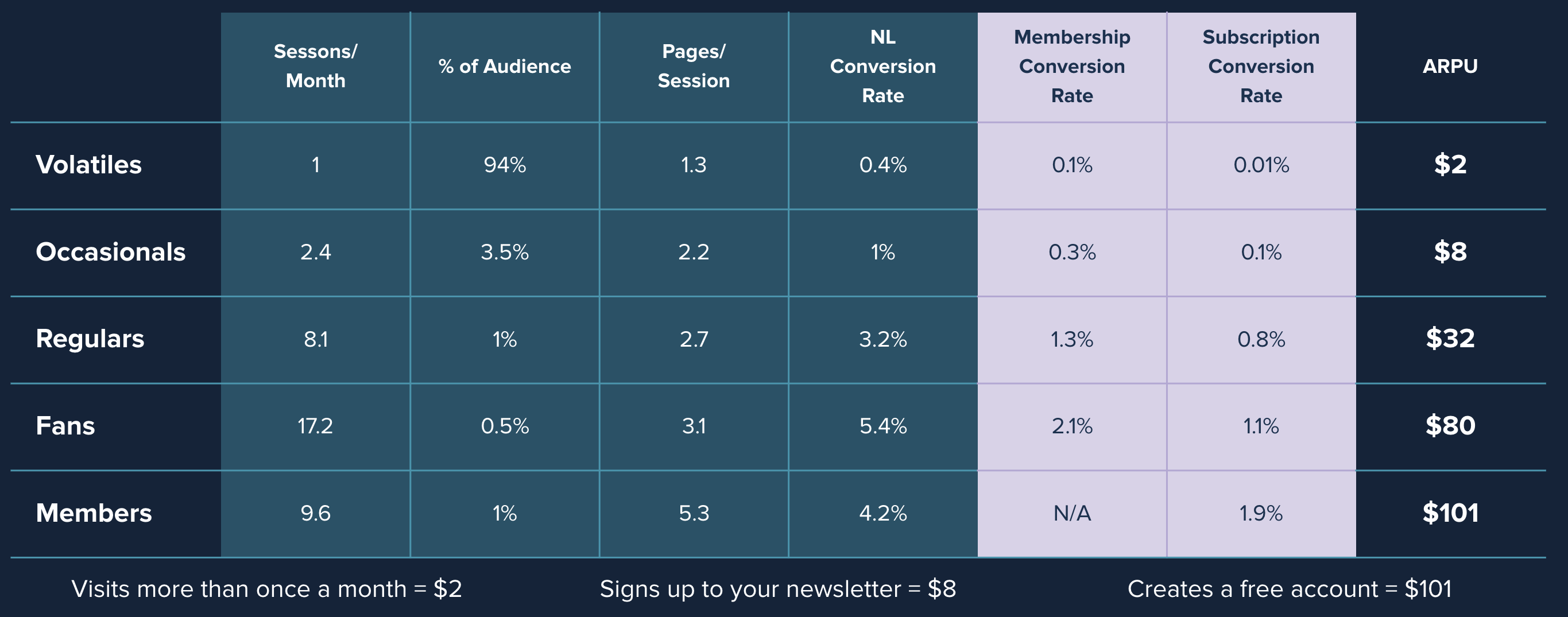
With ARPU as your north star metric, you will see the value in all of the small engagement and conversion steps rather than solely focusing on conversion rates, which we now know is not optimal for a digital publisher’s reader revenue strategy.
A question asked during the webinar: How do you decide what dollar value to give to each conversion step?
It actually doesn't really matter.
The whole idea and importance of this metric is that you are deciding how valuable a specific action is to you and your business model prior to the subscription conversion.
For instance, your data could tell you that newsletter sign up plays a significant role in increasing a user's propensity to subscribe (i.e. the majority of your subscribers signed up X months prior to converting). This step is therefore hugely valuable in your premium strategy, more so than visiting your site more than once per month.
However, you find that creating a free account is even more valuable than this and has the added benefit of increasing ad revenue, so you place registration as the next step in the funnel and give it a higher ARPU value than newsletter sign up.
And, remember, value doesn't have to be money...
- Increased engagement (recency, frequency and volume of visit)
- First-party data collection (such as email address) for understanding your audience
- Custom reader ID and tracking across site
- Personalization and potential to improve the user experience
- Targeted advertising
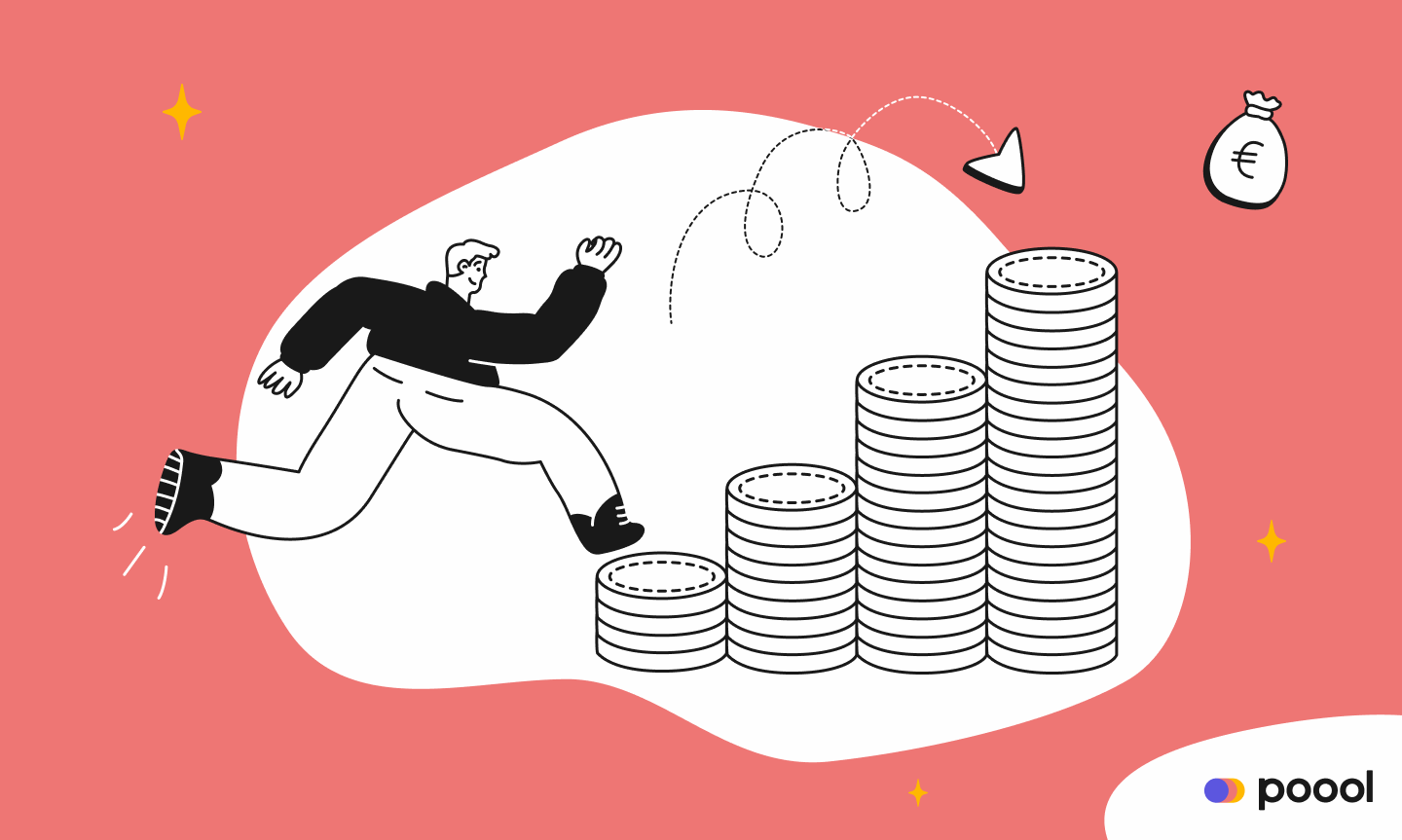
3) Build loyalty journeys that look different based on a user’s context
Mobile vs desktop
Users on mobile engaged for less time than their desktop counterparts when reading longform content greater than about 5,000 words. But the data is actually very similar for mobile vs desktop.
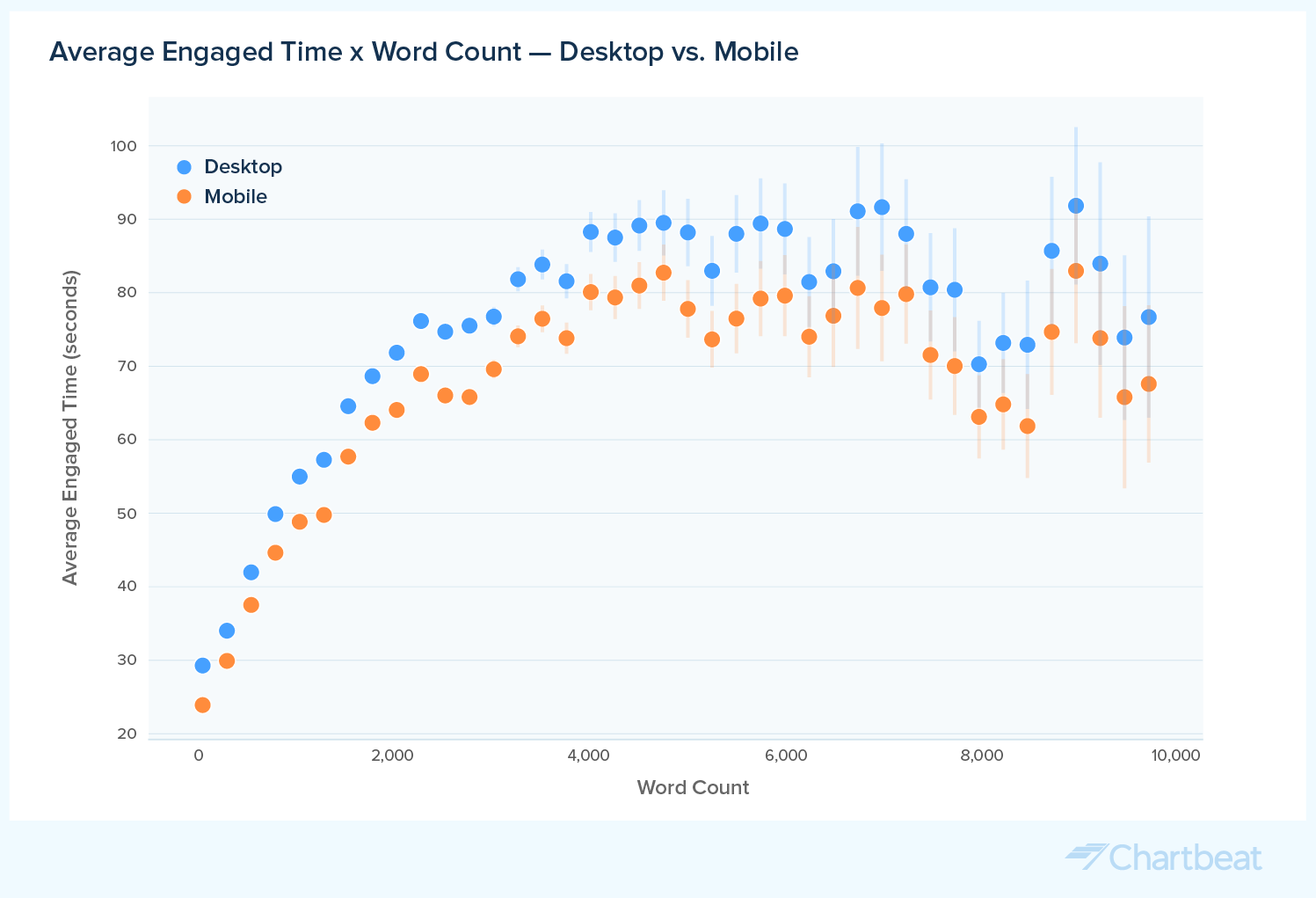
The key take-away here though is to consider how scroll depth and engagement will differ based on device used, something you should use to inform your content strategy on mobile vs desktop.
Conversion behavior also differs based on device.
Globally, about 75% of users who access online news content are on a mobile. This of course differs around the world, but the general trend is that mobile is predominantly used for accessing content, whilst it's actually the least common place for users to subscribe.
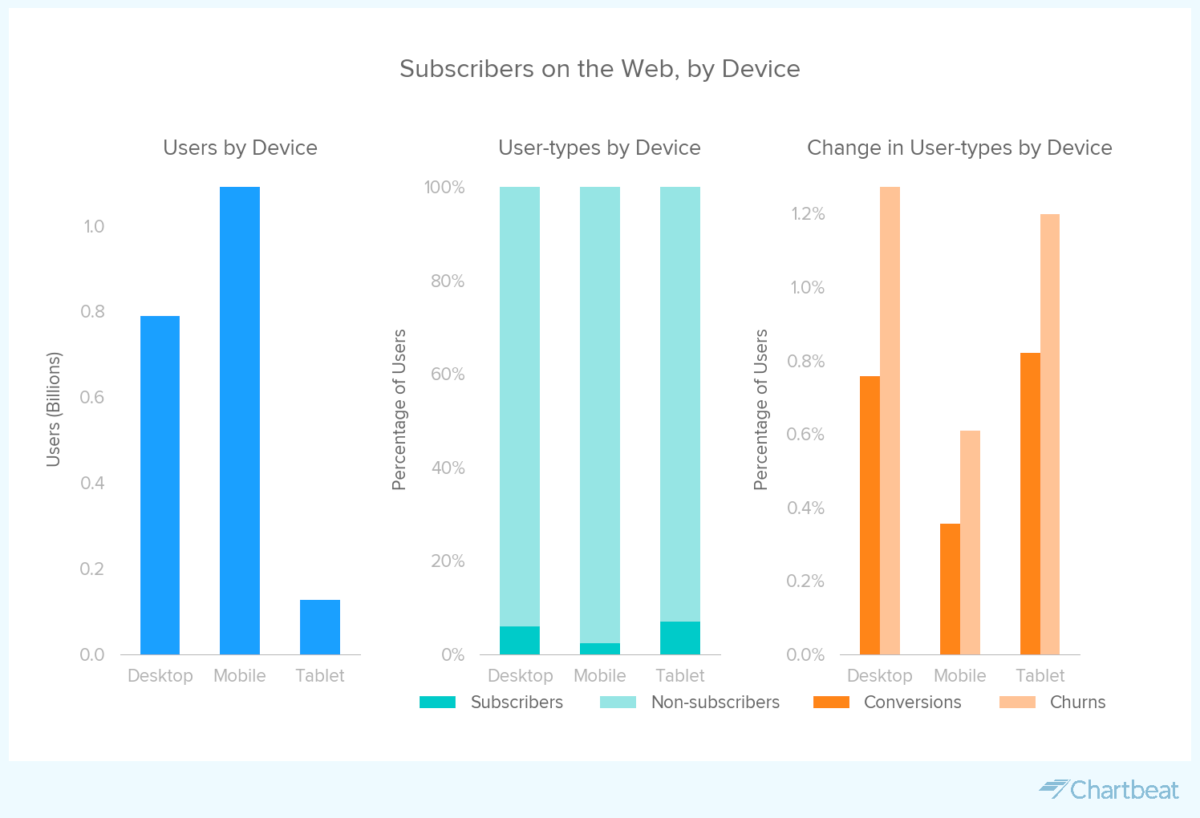
To improve these conversion rates, don't solely look at publishers - consider how other online businesses are doing it right on mobiles, such as Amazon or Netflix. It's not enough to serve a lot of content, you have to build engaging experiences and gradually convert over time.
For instance, Poool allows publishers to segment audiences based on device and personalize the experience accordingly. For users accessing content on mobile, you could consider:
- Offering a discovery pass in exchange for account creation
- Promote newsletter sign up (like La Croix who chose to focus on engagement and soft conversion on mobile, saving the harder conversion steps for desktop)
- Personalize the paywall design - reduce text, shorten the format, remove images, add other funnel steps into the wall (like Le Petit Journal who increase conversion rates on mobile by 200% with this paywall)
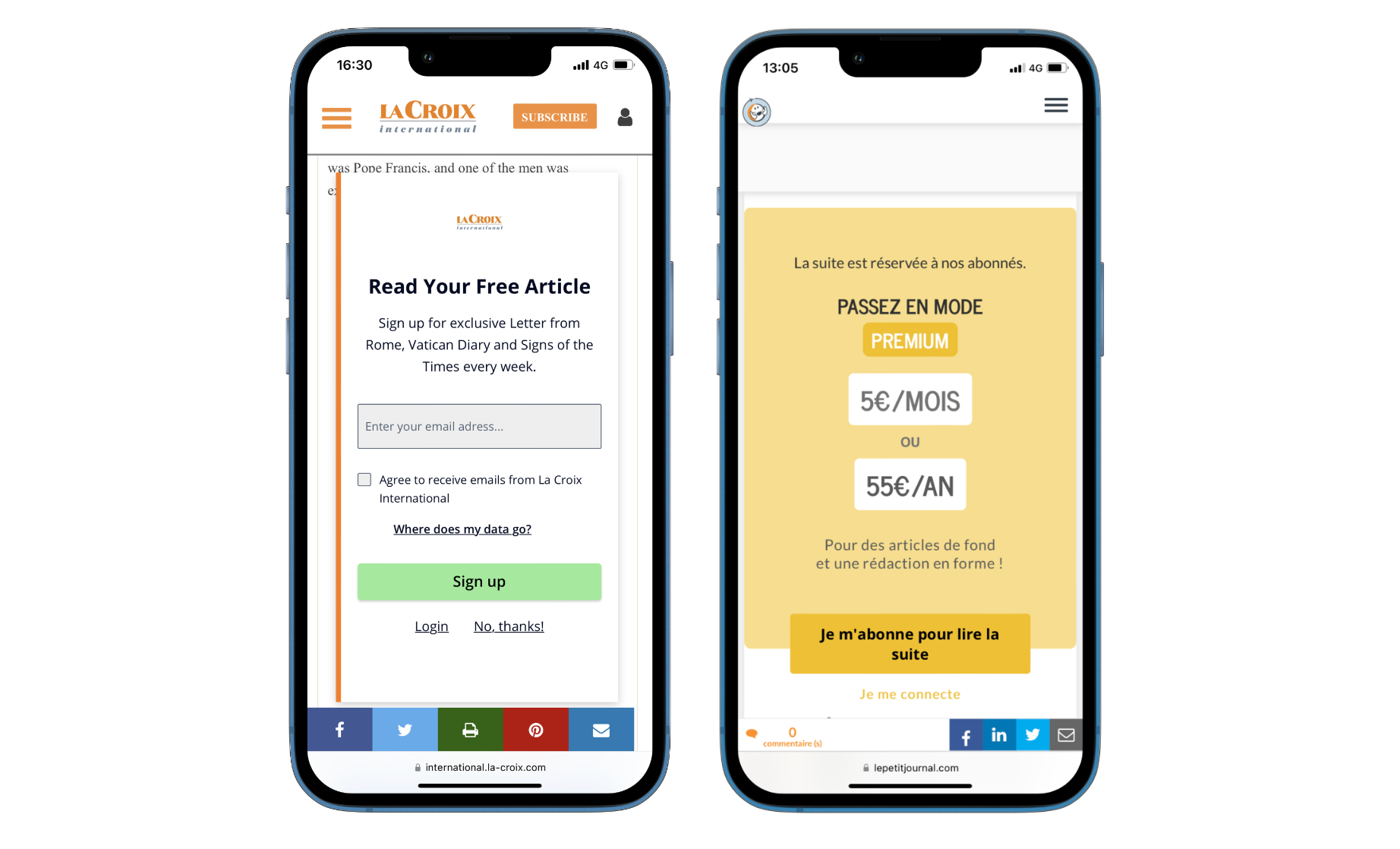
Of course, it's difficult to know exactly what will increase click-through and conversion rates on your specific website and content, so it's essential to continuously run A/B tests, learn about your audience behavior, optimize and iterate.
Key Takeaways & Resources
- Align on the hard and soft conversion events that power your
growth strategy - Combine Two approaches to measurement — behavior (RFV), consumption (attribution models)
- Prioritize ARPU over conversion rates and don’t forget about mobile
- Leverage engagement data and audience segmentation to build better reader experiences
Find the white paper that built the foundations of this webinar, with additional data and strategic advice on the Chartbeat Blog.
You may also be interested in:

